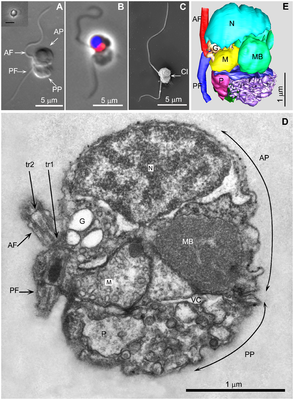Picomonas judraskeda
| Picomonas judraskeda | ||||||||||||
|---|---|---|---|---|---|---|---|---|---|---|---|---|

Picomonas judraskeda |
||||||||||||
| Systematics | ||||||||||||
|
||||||||||||
| Scientific name of the tribe | ||||||||||||
| Picozoa | ||||||||||||
| Seenivasan, Sausen, Medlin & Melkonian, 2013 | ||||||||||||
| Scientific name of the class | ||||||||||||
| Picomonadea | ||||||||||||
| Seenivasan, Sausen, Medlin & Melkonian, 2013 | ||||||||||||
| Scientific name of the order | ||||||||||||
| Picomonadida | ||||||||||||
| Seenivasan, Sausen, Medlin & Melkonian, 2013 | ||||||||||||
| Scientific name of the family | ||||||||||||
| Picomonadidae | ||||||||||||
| Seenivasan, Sausen, Medlin & Melkonian, 2013 | ||||||||||||
| Scientific name of the genus | ||||||||||||
| Picomonas | ||||||||||||
| Seenivasan, Sausen, Medlin & Melkonian, 2013 | ||||||||||||
| Scientific name of the species | ||||||||||||
| Picomonas judraskeda | ||||||||||||
| Seenivasan , Sausen , Medlin & Melkonian , 2013 |
Picomonas judraskeda is a few microns large heterotrophic protozoa, which is found in marine plankton and the first identified type from the strain of Picozoa is. The species was part of a doctoral thesis by means of a fluorescent mitochondria - the marker of a sea water sample before the harbor of Helgoland was taken at a depth of 5 meters, isolated and then cultured in the laboratory. At the same time as the species, the genus, family, order and class were described and the smallest forms of living organisms floating freely in the water, known so far as Picobiliphyta, were described as the new strain Picozoa.
features
Picomonas judraskeda has a length of 2.6 to 3.8 µm and a width of 2 to 2.5 µm. There are two flagella on the cell , an anterior (front) with a length of 12 to 14 µm, the posterior (rear) is 7 to 9 µm long. The cell is divided by a deep constriction into two parts, an anterior with the typical organelles of eukaryotic cells , including the musculoskeletal system for the two flagella, the other posterior serving of food intake and consists of a membrane bag with a complex cytoskeleton , as well as a cell mouth with a width of 150 nm.
Move
The locomotion of Picomonas judraskeda is unique. After a long period of rest, the unicellular organisms suddenly jump about 3 to 5 µm in an anterior direction, then slowly move about 12 µm in the opposite direction, only to suddenly shoot extremely quickly from their original position. The art epithet judraskeda refers to this sequence of movements, known as jump, drag and skedaddle-cycle (German: “Jump, crawl and tower cycle”) .
nutrition
So far it is unknown what Picomonas judraskeda feeds on. The opening of the cell mouth is too small to accommodate bacteria , the preferred food of many protists . The protozoan probably takes up organic molecules from the sea water; these can be lipopolysaccharides from the outer membrane of gram-negative bacteria or viruses .
literature
- Ramkumar Seenivasan, Nicole Sausen, Linda K. Medlin, Michael Melkonian: Picomonas judraskeda Gen. Et Sp. Nov .: The First Identified Member of the Picozoa Phylum Nov., a Widespread Group of Picoeukaryotes, Formerly Known as 'Picobiliphytes'. PLoS ONE 8 (3): e59565. doi: 10.1371 / journal.pone.0059565
- Lara Winkler: New tribe discovered. Animal, not plant , page 6 in Laborjournal , Service magazine for medicine and life sciences, issue 4/2013, LJ-Verlag Herfort and Sailer, ISSN 1612-8354
Individual evidence
- ↑ Fabrice Not, Klaus Valentin, Khadidja Romari, Connie Lovejoy, Ramon Massana, Kerstin Töbe, Daniel Vaulot, Linda K. Medlin (2007): Picobiliphytes: A Marine Picoplanktonic Algal Group with Unknown Affinities to Other Eukaryotes. Science 315, 253-255. doi : 10.1126 / science.1136264
